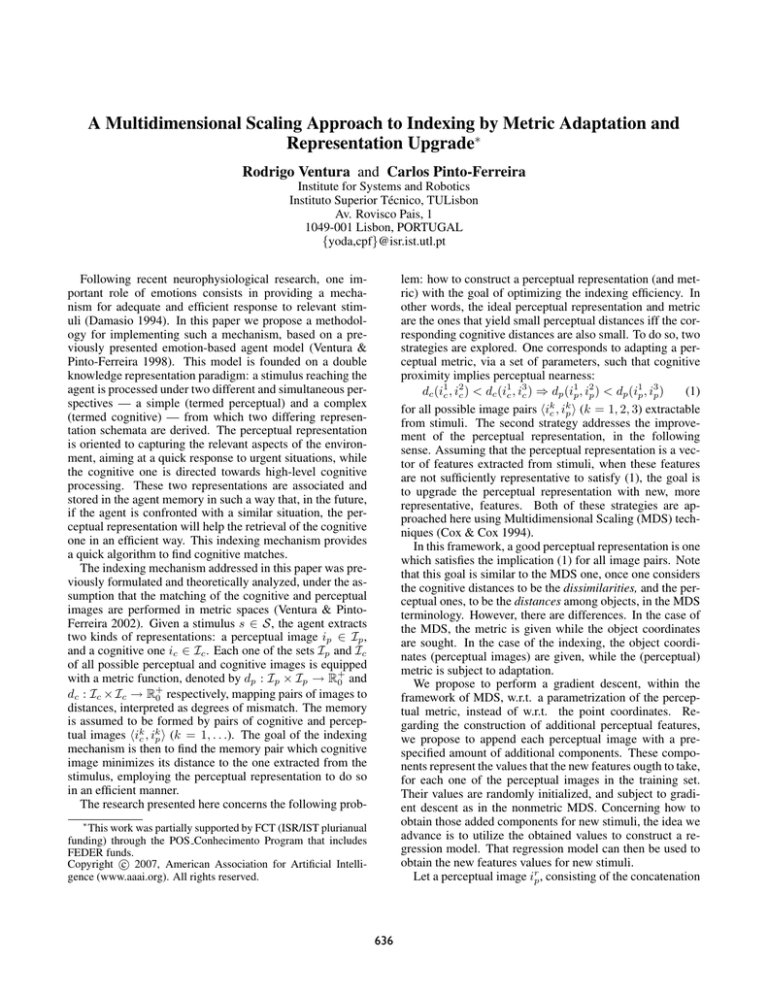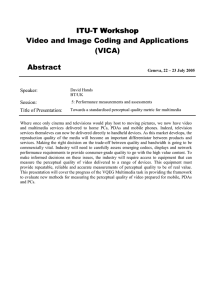
A Multidimensional Scaling Approach to Indexing by Metric Adaptation and
Representation Upgrade∗
Rodrigo Ventura and Carlos Pinto-Ferreira
Institute for Systems and Robotics
Instituto Superior Técnico, TULisbon
Av. Rovisco Pais, 1
1049-001 Lisbon, PORTUGAL
{yoda,cpf}@isr.ist.utl.pt
lem: how to construct a perceptual representation (and metric) with the goal of optimizing the indexing efficiency. In
other words, the ideal perceptual representation and metric
are the ones that yield small perceptual distances iff the corresponding cognitive distances are also small. To do so, two
strategies are explored. One corresponds to adapting a perceptual metric, via a set of parameters, such that cognitive
proximity implies perceptual nearness:
(1)
dc (i1c , i2c ) < dc (i1c , i3c ) ⇒ dp (i1p , i2p ) < dp (i1p , i3p )
k k
for all possible image pairs ic , ip (k = 1, 2, 3) extractable
from stimuli. The second strategy addresses the improvement of the perceptual representation, in the following
sense. Assuming that the perceptual representation is a vector of features extracted from stimuli, when these features
are not sufficiently representative to satisfy (1), the goal is
to upgrade the perceptual representation with new, more
representative, features. Both of these strategies are approached here using Multidimensional Scaling (MDS) techniques (Cox & Cox 1994).
In this framework, a good perceptual representation is one
which satisfies the implication (1) for all image pairs. Note
that this goal is similar to the MDS one, once one considers
the cognitive distances to be the dissimilarities, and the perceptual ones, to be the distances among objects, in the MDS
terminology. However, there are differences. In the case of
the MDS, the metric is given while the object coordinates
are sought. In the case of the indexing, the object coordinates (perceptual images) are given, while the (perceptual)
metric is subject to adaptation.
We propose to perform a gradient descent, within the
framework of MDS, w.r.t. a parametrization of the perceptual metric, instead of w.r.t. the point coordinates. Regarding the construction of additional perceptual features,
we propose to append each perceptual image with a prespecified amount of additional components. These components represent the values that the new features ougth to take,
for each one of the perceptual images in the training set.
Their values are randomly initialized, and subject to gradient descent as in the nonmetric MDS. Concerning how to
obtain those added components for new stimuli, the idea we
advance is to utilize the obtained values to construct a regression model. That regression model can then be used to
obtain the new features values for new stimuli.
Let a perceptual image irp , consisting of the concatenation
Following recent neurophysiological research, one important role of emotions consists in providing a mechanism for adequate and efficient response to relevant stimuli (Damasio 1994). In this paper we propose a methodology for implementing such a mechanism, based on a previously presented emotion-based agent model (Ventura &
Pinto-Ferreira 1998). This model is founded on a double
knowledge representation paradigm: a stimulus reaching the
agent is processed under two different and simultaneous perspectives — a simple (termed perceptual) and a complex
(termed cognitive) — from which two differing representation schemata are derived. The perceptual representation
is oriented to capturing the relevant aspects of the environment, aiming at a quick response to urgent situations, while
the cognitive one is directed towards high-level cognitive
processing. These two representations are associated and
stored in the agent memory in such a way that, in the future,
if the agent is confronted with a similar situation, the perceptual representation will help the retrieval of the cognitive
one in an efficient way. This indexing mechanism provides
a quick algorithm to find cognitive matches.
The indexing mechanism addressed in this paper was previously formulated and theoretically analyzed, under the assumption that the matching of the cognitive and perceptual
images are performed in metric spaces (Ventura & PintoFerreira 2002). Given a stimulus s ∈ S, the agent extracts
two kinds of representations: a perceptual image ip ∈ Ip ,
and a cognitive one ic ∈ Ic . Each one of the sets Ip and Ic
of all possible perceptual and cognitive images is equipped
with a metric function, denoted by dp : Ip × Ip → R+
0 and
dc : Ic × Ic → R+
0 respectively, mapping pairs of images to
distances, interpreted as degrees of mismatch. The memory
is assumed to be formed by pairs of cognitive and perceptual images ikc , ikp (k = 1, . . .). The goal of the indexing
mechanism is then to find the memory pair which cognitive
image minimizes its distance to the one extracted from the
stimulus, employing the perceptual representation to do so
in an efficient manner.
The research presented here concerns the following prob∗
This work was partially supported by FCT (ISR/IST plurianual
funding) through the POS Conhecimento Program that includes
FEDER funds.
c 2007, American Association for Artificial IntelliCopyright gence (www.aaai.org). All rights reserved.
636
of q numerical features xr1 , . . . , xrq , extracted from a given
stimulus, with p additional components yr1 , . . . , yrp , be denoted by the vector irp = (xr1 , . . . , xrq , yr1 , . . . , yrp )T .
These additional components correspond to the values that
the new features ought to take for that particular perceptual image. The perceptual metric employed here is
parametrized by q coefficients θ1 , . . . , θq , taking the form
q
p
(yri − ysi )2 (2)
θ2 (xri − xsi )2 +
drs = i=1
i
after sorting all these images w.r.t. the perceptual distances,
determine which n-th image pair ikc , ikp on the resulting ordered list has the minimum cognitive distance to ic , ip . In
the ideal case, it corresponds to the first one, and thus an
eval-order of 1. Higher values correspond to worse performance.
To validate the proposed methodology, a simple testbed was devised. Random points x ∈ Rc (simulating
stimuli) were uniformly drawn from an hypercube of unit
side length. The cognitive images ic ∈ Rc were set to
the components of x multiplied by some fixed coefficients
W = diag(w1 , . . . , wc ) between 0 and 2 each: ic = Wx.
These coefficients introduce different degrees of relevance
to the components of ic . The perceptual images were obtained by concatenating two vectors: the p first components of x weighted by a second set of fixed coefficients
V = diag(v1 , . . . , vp ) (p ≤ c); and a vector u of n random numbers (noise) between 0 and 1. Thus, the perceptual
images have p + n components: ip = [(Vx)T |uT ]T .
In the first phase of experimentation, no additional perceptual components were considered, and the cognitive and
perceptual dimensions were made equal (c = p, n > 0). The
results have shown that the algorithm was able to both (1)
successfully determine the relevance of each components,
in the form of their weights W regarding the cognitive distance, and (2) to discard the noise perceptual components,
by setting the corresponding weights to zero, thus showing a successful capability of identifying irrelevant features.
Concerning the eval-order performance measure, the results
show a significant improvement of the eval-order performance after using the metric weights found by the algorithm,
when compared to θi = 1.
The second phase of the experimentation comprised the
introduction of new components to the perceptual representation. To do so, the dimension of the cognitive images was
made higher than the perceptual one, i.e., c > p. Thus, the
perceptual metric is performed with less components than
the cognitive one. The first impact of this is that, without the
introduction of new components, the final cost values were
much higher than before, due to lack of fit. This happens
because the perceptual representation has not enought information to be able to faithfuly replicate the cognitive distances. The experimental results show a significant reduction of the final cost values, whenever the total dimensionality of the perceptual representation, including the amount of
new components, is greater or equal than c, thus showing an
improved fit.
i=1
This parametrization corresponds to assigning a weight (relevance) to each perceptual feature before calculating the Euclidean metric. Moreover, when the algorithm assigns a zero
weight to a feature, that feature can be deleted from the perceptual representation, since it is irrelevant (w.r.t. the cognitive matching). The additional components are not weighted
since it would just add redundant degrees of freedom.
The cost function employed here is the sum of the MDS
stress, using the cognitive distances as dissimilarities and
drs as distances, with a regularization term penalizing the
absolute values of the metric parameters
q
|θi |
(3)
J =S+ξ
i=1
This latter term, weighted by ξ, is included in the cost function to drive to zero any weight corresponding to an irrelevant perceptual component.
Based on the standard nonmetric MDS algorithm (Cox &
Cox 1994), we propose the following one:
1. Start with an initial variables vector Λ
=
T
[θ1 · · · θq |y11 · · · ynp ] (e.g., θi = 1, and yri randomly
distributed).
2. Normalize the metric parameter vector (θ1 , . . . , θq )T to
unit norm, since the stress is invariant to scaling of this
vector. The additional components {yri } are, however,
not normalized;
3. Compute the distance set {drs } using the parametrized
perceptual metric (2);
4. Perform the isotonic regression (as in nonmetric MDS) to
obtain the set of distances {dˆrs };
5. Compute the cost; if its value is below a threshold , stop
the algorithm;
6. Find the gradient of the cost function w.r.t. the variables vector Λ, and perform a step of the gradient descent
method;
7. Go to step 2.
In order to evaluate the results, a measure of performance
called eval-order was introduced, aiming at assessing how
well the indexing mechanism would behave. This assessment is performed using a test set disjoint from the training
set employed in the gradient descent (cross-validation). Inspired on the N-best indexing algorithm described in (Ventura & Pinto-Ferreira 2002), the eval-order is defined in the
following way: given a cognitive and perceptual images
pair ic , ip , determine all perceptual distances from it to images in the perceptual memory (i.e., the training set); then,
References
Cox, T. F., and Cox, M. A. A. 1994. Multidimensional
Scaling. London, UK: Chapman & Hall.
Damasio, A. R. 1994. Descartes’ Error: Emotion, Reason
and the Human Brain. Picador.
Ventura, R., and Pinto-Ferreira, C. 1998. Emotion-based
agents. In Proceedings AAAI-98, 1204. AAAI.
Ventura, R., and Pinto-Ferreira, C. 2002. A formal indexing mechanism for an emotion-based agent. In Proceedings
IASTED-2002, 34–40. Malaga, Spain: ACTA Press.
637








